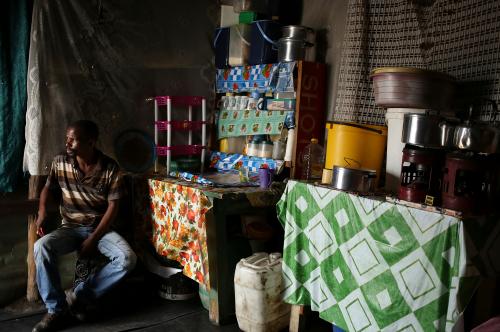Pour lire la version française, cliquez ici.
Sub-Saharan Africa has returned to growth. In order to pursue its structural transformation amid a weak industrial base and high labor costs, the adoption of policies promoting entrepreneurship in the promising service sector should assist in confronting the challenge of absorbing millions of young people into the labor market.
After more than three decades of decline post-independence, most of sub-Saharan Africa has returned to growth. Nevertheless, clouds are forming at the horizon: At the macro level, the continent’s de-industrialization in the 1970s and 1980s has failed to reverse itself, while structural adjustment apparently has worked backward, failing to shift resources toward productive uses and instead toward slow-growth sectors. Can Africa still leverage its latent comparative advantage in labor-intensive light manufacturing to benefit from second-generation offshoring? A special edition of the Revue d’Economie du Développement (Development Economics Review) compiles recent contributions on the analysis of structural transformation and the constraints to sub-Saharan Africa’s industrial development.
findings:
Despite a significant decline in poverty, the elasticity of poverty with respect to growth is weak.
In our contribution, Olivier Cadot, myself, Patrick Plane, Laurent Wagner, and Martha Tesfaye Woldemichael show that the growth elasticity of poverty reduction is weaker in sub-Saharan Africa than in other regions over the 1993-2011 period. They also show that, while this observation might seem normal in rich countries, it also holds true in sub-Saharan Africa’s resource-rich countries. We attribute the weak elasticity to the size of the agricultural sector where populations live on resources-stripped land.
No single factor explains the disappearance of the fragile industrial base.
Entrepreneurial dynamism, as evidenced by export surges in non-commodity sectors, is no more in short supply in sub-Saharan Africa than elsewhere, while export concentration appears to be a characteristic of resource-rich countries rather than the region as a whole. The sole apparent factor is structural adjustment, which seems to have directed surplus agricultural employment toward sectors sheltered from international competition rather than towards manufacturing. Overall, the frail foreign and domestic investments suggest weak rates of return due to risks tied with commercial activity in Africa.
The high labor costs enigma.
Basing their analysis on firm-level data in the manufacturing sector (from the World Bank Enterprise Survey) in 12 sub-Saharan Africa countries and 13 comparators (e.g., Bangladesh, Cambodia, Indonesia, among others), Alan Gelb, Christian Meyer, and Viaya Ramachandran bring a key contribution to the discussion. Notably, African manpower is expensive relative to comparators at the same level of income. For instance, although Kenya and Bangladesh have similar levels of per capita GDP (around $500), Kenya’s median industrial labor cost is four times higher. They estimate a 50 percent premium in labor costs in Africa when compared to same-size firms in comparable countries.
What accounts for this labor-cost difference? Gelb and co-authors identify three possible contributing factors. One is what they call the “enclave effect”: Only productive firms are able to operate, and they pay above-market wage rates to employees. A second possible contributing factor is the fact that labor costs rise more rapidly with firm size in sub-Saharan Africa than elsewhere. This trend could reflect underlying bottlenecks in skilled labor if larger firms employ disproportionately more skilled workers or that unions put pressure on large, formal firms. A third hypothesis is that African labor is more expensive in nominal terms but not in real terms when the values are expressed at purchasing power parity (PPP). The labor cost difference would thus reflect exchange rate distortions rather than labor-market ones.
Gelb and Anna Diofasi explore the last hypothesis by regressing PPP cost levels on GDP per capita and find that, on average, labor cost levels are 30 percent higher in sub-Saharan Africa than in comparators. They then address the list of potential explanatory factors: geographic factors (small island, weak population density, economy size), institutional quality, oversampling of goods primarily consumed by rich people in the consumer basket, poor GDP measures, energy subsidies, aid and Dutch disease, and weak agricultural productivity. All in all, adding all these control variables reduces the gap by half. Sub-Saharan Africa remains an outlier.
Overall, when combined, the three factors justify the donor emphasis on agricultural and infrastructure support, even though the improvements required to absorb the millions of new young entrants on the labor market in the next twenty years would be a tall order. Putting the emphasis on services could be another means to promote employment, development, and convergence in sub-Saharan Africa.
Services: A growth engine?
In their contribution, Ejaz Ghani and Stephen O’Connell argue that the potential of services to act as a “growth escalator” for sub-Saharan Africa’s low-income countries is overlooked. Rodrik (2013), alongside other scholars, has documented a conditional productivity convergence only found in manufacturing. They find non-convergence in the agricultural sector. Nevertheless, they find that during the 1990-2012 period, services were, by far, the largest contributors to GDP growth in low-income and lower-middle-income countries, a pattern they observe in sub-Saharan Africa. Most strikingly in view of the region’s huge employment challenge, the authors show that productivity growth in services has been accompanied by job growth.
Ghani and O’Connell dispel a number of misconceptions underlying the widely held belief that services cannot be a growth engine. First, growing international trade in commercial services implies that foreign demand can contribute to the growth of value added in services alongside domestic ones, providing an exogenous growth driver. Second, the term “services” covers highly heterogeneous activities, some of which (e.g., transport, telecom, or financial services) are increasingly characterized by rapid technical change and therefore by another exogenous growth driver. Third—and largely for the same reasons—contrary to common beliefs, there is little evidence that service jobs are worse in terms of pay and returns to education than manufacturing ones.
These trends stand in contrast to manufacturing, whose share in total employment tends to follow, across countries, a hump-shaped curve in terms of level of development—with a peak attained at lower levels for latecomers like sub-Saharan Africa. Ghani and O’Connell argue that in services where the size is not as important as in industrial firms, policies geared toward the facilitation of entrepreneurship are of critical importance. Conversely, in manufacturing, what matters is attracting multinationals rather than nurturing domestic entrepreneurship.
What are the implications for governments and development partners?
From a country perspective, now that the most egregious restrictions to international trade have been removed across the continent, these conclusions suggest that policies to facilitate the development of services that have become increasingly tradable should be pursued. In our introduction, Cadot and I suggest addressing the “weak links” in the economy, i.e., the non-tradable sectors characterized by particularly low productivity that constrain the development of other sectors. Thus, a deficient energy sector—very often the case in sub-Saharan Africa—or an unreformed banking sector can obviously have negative economy-wide effects, particularly on the sectors best placed to drive structural change, notably through their participation in value added.
From a donor’s perspective, aid can be an important instrument if channeled into supporting the continent’s structural change, and particularly its “weakest link”—i.e., the manufacturing sector and the bottlenecks (e.g., high transport costs and no regular access to electricity)—that undermine it. On the other hand, donors may also want to target the “strong links”—i.e., the most productive sectors—to spearhead development. The most productive firms could get subcontractors to raise their quality standards or provide technical assistance. This is the case, for example, for certain distribution channels that provide assistance to bring agricultural production up to standards. Further studies and policy experimentation will yield the strategy that would generate the best returns.
References
Cadot, Olivier, Jaime de Melo (2016) «Vers une Transformation structurelle en Afrique», Revue d’Economie du Développement, ce numero, n0. 2, 5-18.
Cadot, Olivier, Jaime de Melo, Patrick Plane, Laurent Wagner et Martha Tesfaye Woldemichael (2016) “Industrialisation et Transformation Structurelle : L’Afrique subsaharienne peut-elle se développer sans usisnes?, Revue d’Economie du Développement, n0. 2, 19-50.
Gelb, Alan, Christian Meyer, et Viaya Ramachandran (2016) “Pays pauvres, pays bon marché? Regard Comparatif sur le coût de la main d’œuvre dans le secteur industriel en Afrique ”, Revue d’Economie du Développement, n0. 2, 51-92.
Gelb, Alan, et Anna Diofasi (2016) “Pays Pauvres, pays bon bon marché? Regard Comparatif sur le coût de la main d’œuvre dans le secteur industriel en Afrique », Revue d’économie du développement, n0. 2, 93-142.
Ghani, Ejaz, et Stephen O’Connell (2016) “Les Services Peuvent-ils devenir un escalator de croissance pour les pays à faible revenu ?”, Revue d’Economie du Développement, n0. 2, 143-73.
Rodrik, Dani (2013) “Unconditional Convergence in Manufacturing”, Quarterly Journal of Economics, 128, 165-204.Söderbom, Mans, and Francis Teal (2004) “Size and Efficiency in African Manufacturing Firms: Evidence from Firm-Level Panel Data”, Journal of Development Economics, 73(1), 369-94.







Commentary
Pathways to structural transformation in Africa
October 30, 2017